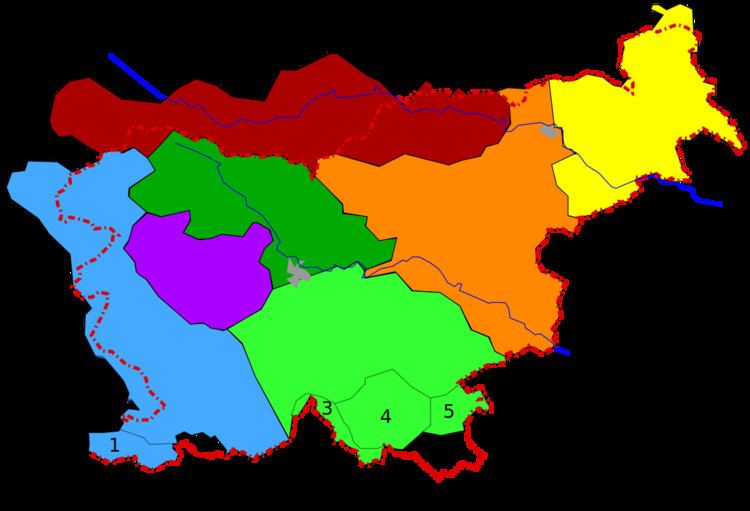 | ||
Slovene dialects (Slovene: slovenska narečja) are the regional spoken varieties of Slovene, a South Slavic language. Spoken Slovene is often considered to have at least 48 dialects (narečja) and subdialects (govori). The exact number of dialects is open to debate, ranging from as many as 50 to merely 7. The various dialects are so different from each other that a speaker of one dialect may have a very difficult time understanding a speaker of another, particularly if they belong to different regional groups. In such communication, standard Slovene is used per convention. Slovene dialects are part of the South Slavic dialect continuum, linked with Serbo-Croatian to the south and bordering Friulian and Italian to the west, German to the north, and Hungarian to the east.
Contents
History of classification
The first attempts to classify Slovenian dialects were made by Izmail Sreznevsky in the early 19th century, followed by Jan Niecisław Baudouin de Courtenay (focusing on Resia, Venetian Slovenia, Cerkno, and Bled), Karel Štrekelj (focusing on the Karst), and Ivan Scheinig (focusing on Carinthia). This was followed by efforts by Ivan Grafenauer (Gail Valley), Josip Tominšek (Savinja Valley), and others. Efforts before the Second World War were spearheaded by Lucien Tesnière, Fran Ramovš, and Aleksander Isachenko, and after the war by Tine Logar and Jakob Rigler (sl). Eventually, the classification proposed by Ramovš was accepted with corrections and additions by Logar and Rigler, published in 1983 as the Karta slovenskih narečij (Map of Slovenian Dialects).
Criteria for classification
The division of Slovenian into dialects is based on various non-linguistic and linguistic factors. Non-linguistic factors include settlement patterns and geographical features (rivers, mountains) that helped shape various isoglosses. Linguistic factors include language contact with non-Slavic languages to some extent, phonological and prosodic elements in particular, and to a lesser extent word-formational, lexical, and inflectional elements. Specifically, the primary distinguishing linguistic features are 1) preservation or loss of pitch accent, 2) reflexes of nasal *ę, nasal *ǫ, jat (ě), and the yers (ъ, ь), and 3) (to a lesser extent) vowel inventory, diphthongization, and degree and type of vowel reduction.
Regional groups
The main regional groups are:
- The Upper Carniolan dialect group (gorenjska narečna skupina), spoken in most of Upper Carniola and in Ljubljana. Among other features, this group is characterized by monophthongal stressed vowels, an acute semivowel, pitch accent, standard circumflex shift, and two accentual retractions with some exceptions. It features narrowing of o and e in preaccentual position, akanye (reduction of o to a) in postaccentual position, and strong syncope. There is a partial development of g to [ɣ], preservation of bilabial w, and general hardening of soft l and n.
- The Lower Carniolan dialect group (dolenjska narečna skupina), spoken in most of Lower Carniola and in the eastern half of Inner Carniola. Among other features, this group is characterized by pitch accent, extensive dipththongization (ei, ie, uo), an a-colored semivowel, shift of o > u, and partial akanye.
- The Styrian dialect group (štajerska narečna skupina), spoken in central and eastern Slovenian Styria and in the Lower Sava Valley and Central Sava Valley. Among other features, this group is characterized by loss of pitch accent, tonemically high and lengthened accented syllables, lengthening of accented short syllables, and frequent development of a > ɔ, and u > ü in the eastern part of the territory.
- The Pannonian dialect group (panonska narečna skupina), or northeastern dialect group, spoken in northeastern Slovenia (Prekmurje, in the eastern areas of Slovenian Styria), and among the Hungarian Slovenes. Among other features, this group is characterized by loss of pitch accent, non-lengthened short syllables, and a new acute on short syllables.
- The Carinthian dialect group (koroška narečna skupina): spoken by Carinthian Slovenes in Austria, in Slovenian Carinthia, and in the northwestern parts of Slovenian Styria along the upper Drava Valley, and in the westernmost areas of Upper Carniola on the border with Italy. Among other features, this group is characterized by late denasalization of *ę and *ǫ, a close reflex of long yat and open reflex of short yat, lengthening of old acute syllables and short neo-acute syllables, and an e-like reflex of the long semivowel and ə-like reflex of the short semivowel.
- The Littoral dialect group (primorska narečna skupina), spoken in most of the Slovenian Littoral (except for the area around Tolmin and Cerkno, where Rovte dialects are spoken) and in the western part of Inner Carniola; it is also spoken by Slovenes in the Italian provinces of Trieste and Gorizia, and in the mountainous areas of eastern Friuli (Venetian Slovenia and Resia). This group includes very heterogeneous dialects. Among other features, it is characterized by diphthongization of yat > ie and o > uo, and late denasalization of *ę and *ǫ. The western dialects in this group have preserved pitch accent whereas the others have a non-tonal stress accent.
- The Rovte dialect group (rovtarska narečna skupina), spoken in the mountainous areas of west-central Slovenia, on the border between the Slovenian Littoral, Upper Carniola, and Inner Carniola, in a triangle between the towns of Tolmin, Škofja Loka, and Vrhnika. Among other features, this group is characterized by shortening of long diphthongal ie and uo, akanye, and general development of g to [ɣ].
- The Mixed Kočevje subdialects (mešani kočevski govori), a catch-all category for the Slovene dialects of heterogeneous origin now spoken in the Kočevje region.
List of dialects
The following grouping of dialects and subdialects is based on the 1983 map of Slovene dialects by Fran Ramovš, Tine Logar, and Jakob Rigler (sl) (from which the first Slovene term listed in parentheses is taken) and other sources.
